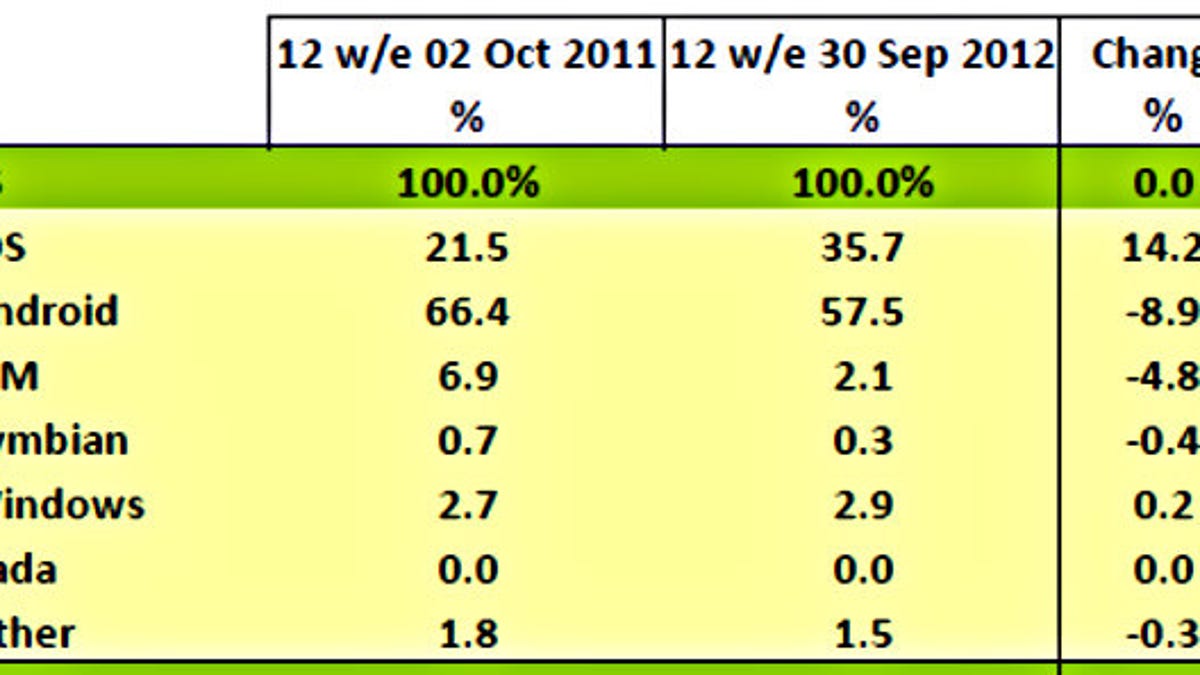iOS growth outpaces Android in U.S. and U.K., but not elsewhere
The momentum is with Apple and the iPhone 5, at least in the U.S. and Britain. In other markets, though, iOS slipped in the final weeks before the new iPhone's arrival.

The Android operating system has largely held its own against Apple's iOS in the latest lap of the smartphone races.
Figures released today from Kantar Worldpanel ComTech show Android continuing to make market share gains across Europe in the 12 weeks of sales that ended September 30. In that region, Google's mobile OS rose to a 67 percent share, compared with 51 percent for the same stretch a year ago, while iOS edged down slightly to 16.5 percent.
It was a different story in the U.S. for the 12-week period. In Apple's home market, iOS leaped from 21.5 percent a year ago to nearly 38 percent, while Android slipped from just over 66 percent to 57.5 percent. Apple also saw an increase in the U.K. (to 28 percent, up from 18 percent), and Android did, too (to 58 percent, up from 53 percent).
Apple sold more than 5 million units of the iPhone 5 during the smartphone's debut weekend in late September, and for that quarter as a whole (ended September 29), it sold 26.9 million iPhones overall, an increase of 58 percent from the same period last year.
Kantar expects the Apple growth trend to continue.
"While this latest data set only includes one week of iPhone 5 sales, we can see that in markets with a large number of existing Apple customers, sales have already seen a significant boost," Kantar's Dominic Sunnebo said in a statement. "We expect this momentum to be fully realized in the next set of results."
Apple put the iPhone 5 on sale on September 21 in the U.S., Australia, Canada, France, Germany, Hong Kong, Japan, Singapore and the U.K., and on September 28 in 22 additional countries in Europe and elsewhere.
In a number of those countries, iOS share declined for the 12-week period. In Australia, for instance, iOS slipped to 23 percent (from 28 percent) while Android rose to 67 percent (from 53 percent). In France, iOS edged down to 12 percent (from 15 percent) as Android rose to 61 percent (from 48 percent). In Germany, iOS slumped to 12 percent (from 22 percent) at the same time that Android grew to 78 percent (from 54 percent).
RIM and Symbian, meanwhile, continued to slide to ever more minuscule shares in the U.S. and the U.K. -- RIM down to 2 percent and 9 percent in the two countries, respectively, and Symbian to below 1 percent in both locales.
Ahead of this week's formal introduction of Windows Phone 8, Microsoft's share in the U.S. essentially held steady, up a fraction to 2.9 percent for the 12-week period, and saw a slightly larger rise in Britain to 4.2 percent. The shares for Microsoft, RIM, and Symbian showed roughly similar patterns in the other countries surveyed.
And in its initial findings from China, Kantar puts the smartphone OS rankings this way: Android (65 percent), iOS (19 percent), Symbian (8 percent), Windows (6 percent), RIM (0.1 percent), and other (under 3 percent).
Kantar Worldpanel ComTech derives its findings from consumer panels in 12 countries: the U.K., France, Italy, Germany, Spain, the U.S., China, Japan, Australia, Argentina, Brazil, and Mexico.

